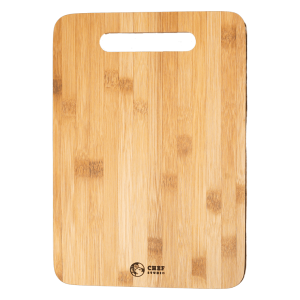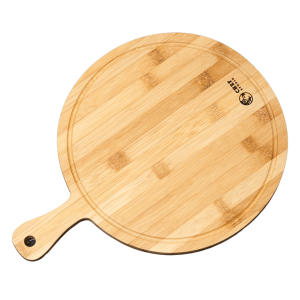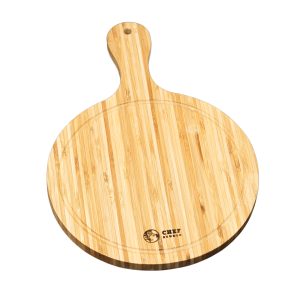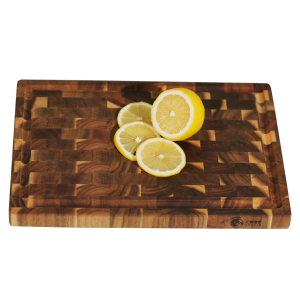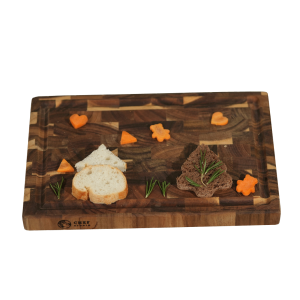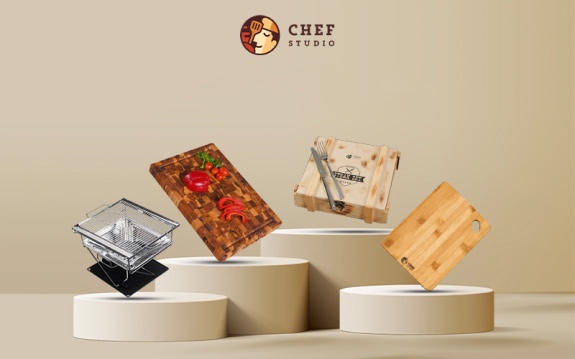Bamboo vs Acacia cutting board – Which is better?
When it comes to choosing the perfect cutting board for your kitchen, the options seem endless. In this exploration of kitchen essentials, Chef Studio will delve into the characteristics of bamboo vs acacia cutting boards to determine which one emerges as the ultimate choice.
Bamboo cutting board pros and cons
Before comparing bamboo vs acacia cutting boards, let’s learn about the advantages and disadvantages of bamboo cutting boards:
Pros
Eco-Friendly
Is bamboo good as a cutting board? Yes. Bamboo is a rapidly renewable resource, making it an eco-friendly choice for cutting boards. Its fast growth rate and minimal impact on the environment make it a sustainable option.
Resistance to Warping
Bamboo cutting boards have minimal chances of warping, especially when properly cared for and maintained. Regular oiling and maintenance can help prevent any potential warping due to moisture exposure.
Affordability
Bamboo cutting boards are relatively inexpensive to produce, making them affordable for consumers. Despite their eco-friendly and durable qualities, they are often priced competitively compared to other materials.
Organic Look and Feel
Bamboo provides a clean and organic aesthetic that many chefs prefer in their kitchen tools. Its uniform light brown color and natural grain pattern adds a touch of elegance to any kitchen.
Cons
Potential for Bacterial Build-Up
The porous nature of bamboo can absorb bacteria if not properly cleaned and sanitized. Regular sanitation and care are necessary to prevent bacterial growth and ensure food safety.
High Silica Content
Bamboo contains silica, which can be abrasive and wear down knife edges faster than wood cutting boards. This may require more frequent sharpening of knives used on bamboo cutting boards.
Splintering
Bamboo, being a grass rather than wood, can develop “fuzzy” splinters more quickly than traditional wood cutting boards. These splinters may transfer into food, posing a risk of injury or discomfort if ingested.
Despite these drawbacks, proper care and maintenance can help mitigate the cons of bamboo cutting boards, allowing users to enjoy their benefits for years.
Acacia cutting board pros and cons
Acacia cutting boards have gained popularity for several reasons, boasting a range of advantages that make them a preferred choice for many kitchen enthusiasts. Before considering bamboo vs acacia cutting boards, here are some of the pros and cons of acacia cutting boards:
Pros
Resilient and Water-Resistant
Acacia wood is known for its durability and ability to withstand moisture. This makes acacia cutting boards ideal for use in the kitchen, where they are likely to encounter liquids from fruits, vegetables, and meats.
Attractive Natural Grain
One of the standout features of acacia wood is its visually appealing natural grain. The heartwood of the acacia tree showcases a rich reddish to deep dark brown color, with a grain pattern that adds character and charm to the cutting board. Whether left untreated or polished, acacia cutting boards exude a rustic elegance that enhances the aesthetics of any kitchen.
Antibacterial Qualities
Acacia wood possesses inherent antibacterial properties, making it a hygienic choice for food preparation and serving. These antibacterial qualities help inhibit the growth of bacteria on the surface of the cutting board, minimizing the risk of food contamination.
Durable
Acacia wood cutting boards are known for their durability and ability to withstand sharp knives over extended periods. They are less prone to scratches and knife marks compared to other materials.
Cons
Susceptible to Scratches
While acacia wood is resilient, it is not completely immune to scratches and marks. Over time, frequent use of knives and utensils on the surface of the cutting board may result in visible scratches and wear. However, regular maintenance and proper care can help minimize the appearance of scratches and preserve the board’s appearance.
Requires Regular Maintenance
Like any wooden cutting board, acacia cutting boards require regular maintenance to ensure longevity and optimal performance. This includes periodic oiling to prevent drying and cracking, as well as thorough cleaning after each use to remove food particles and bacteria.
Overall, acacia cutting boards offer a blend of durability, aesthetic appeal, and antibacterial properties that make them a popular choice for home kitchens. With proper care and maintenance, an acacia cutting board can serve as a reliable and stylish addition to any culinary workspace.
Compare bamboo vs acacia cutting board
When comparing bamboo vs acacia cutting boards, it’s important to consider several factors to determine which option is better suited to your needs. Here’s a breakdown of the key differences between the two materials:
Durability
Is bamboo or acacia better for cutting boards? Acacia wood is generally considered more durable than bamboo due to its hardwood nature. It is sturdier and more resistant to wear and tear, making it a longer-lasting option for your kitchen.
Bamboo vs Acacia cutting board porosity
While both acacia and bamboo are porous materials, acacia tends to be slightly more porous than bamboo. However, acacia wood contains more natural oils, providing better resistance to liquids and reducing the risk of water damage, rot, and mold.
Substance Resistance
Acacia wood’s higher oil content also makes it more resistant to water, rot, and mold compared to bamboo. While bamboo does have natural antimicrobial properties, it may still be affected by prolonged exposure to water.
Color Compatibility
Acacia wood has a more natural and rustic appearance, while bamboo offers a polished and refined look. Choosing bamboo or acacia cutting board depends on your personal preference and how well it complements your kitchen decor.
Maintenance
Acacia wood cutting boards are easier to maintain due to their higher oil content, which naturally repels water and helps prevent mold and rot. On the other hand, bamboo cutting boards require regular maintenance to ensure longevity and prevent water damage.
Bamboo vs Acacia cutting board cost
Bamboo cutting boards are typically more affordable than acacia wood boards. Bamboo is a fast-growing plant that requires less time and labor to produce, resulting in lower production costs.
Knife Friendliness
Acacia wood is harder than bamboo, making it tougher on knives and potentially dulls the blade faster. However, acacia’s durability may offset this issue, especially when using end or face-grain cutting boards.
In conclusion, both bamboo and acacia cutting boards have their own set of advantages and disadvantages. Acacia wood offers greater durability, resistance to substances, and ease of maintenance, but it may come at a higher cost. Whereas bamboo cutting board is more affordable and has natural antimicrobial properties, it may require more frequent maintenance and be less durable in the long run. Ultimately, the best choice bamboo vs acacia cutting board depends on your priorities and preferences for your kitchen.


